There were 3 Santa Feans exhibiting at Codex this year. One was printmaker Madeleine Durham, who showed her new gorgeous paste papers. Below are a couple of examples. See all of them here.
There were 3 Santa Feans exhibiting at Codex this year. One was printmaker Madeleine Durham, who showed her new gorgeous paste papers. Below are a couple of examples. See all of them here.
The other day I joined some local bookmakers for a session of their fabric book study group. The group started in January and will meet monthly throughout the year. My friend Suzanne was showing off her knitting projects and the group was going to spend the two hours knitting. Suzanne knits for relaxation, using large (#13) needles and yarn, wire, fabric cut into strips, lace, a glove cut into strips with the fingers hanging down… you name it. They are colorful and, well, I just want to reach out and touch them. She just knits, no purl. She told us that when we wanted to change to another inclusion to just tie it on with a knot, not waiting until the end of a row. We could leave the ends hanging out or weave them in. I wanted to see what Suzanne had to say and to see if, after my shifu experience last week, I might include knitting in some books. Here’s the results:
One of Suzanne’s examples:
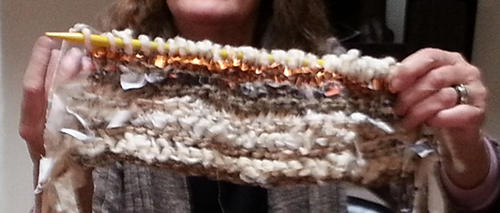
Caroline used fabric that she tore (rather than cut) after staining in coffee and tea:
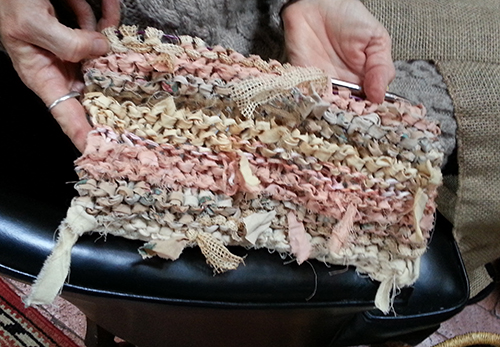
Roberta brought plastic bags and cut them up for us to include
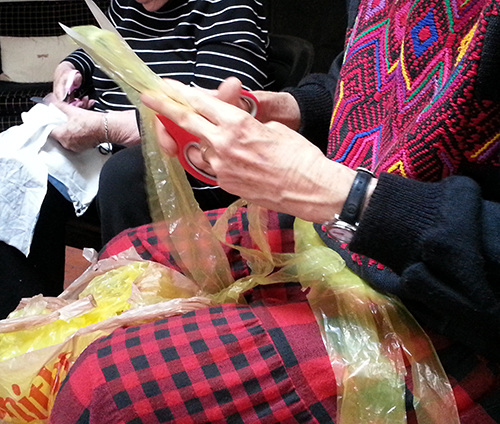
Miriam was a guest like me. She had been inspired by Suzanne’s approach and had already made a piece incorporating buttons, glass beads and an old tie (read more on Miriam’s blog)
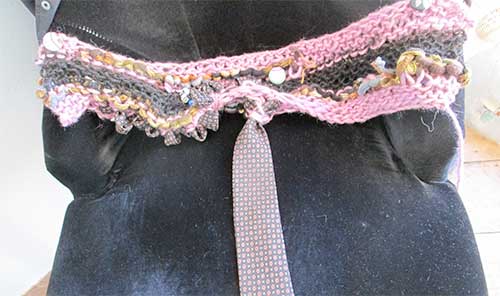
And here’s mine. I knitted in yarn, Roberta’s plastic bag, a piece of plastic lanyard rope, some piping, some roving that kept breaking, old kimono fabric… what a fun afternoon!
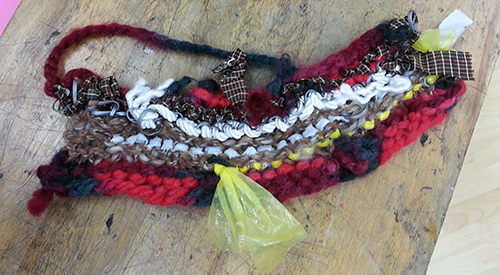
One of the more amazing things I saw at Codex was Rebecca Chamlee of Pie in the Sky Press‘s letterpress printed botanical prints. She says they are “letterpress botanical images of California native trees, collected from Corriganville Regional Park in Simi Valley, California, printed four-color in tight registration with photo polymer plates.” Below is one of them (see them all here). She also has a new book, Where Stucco Meets Chaparral that includes the botanical prints. On her blog she has several great posts about making and binding the book — be sure to check them out.
Codex was awfully inspiring. I’ve been planning a book with curved type for quite some time, and now I can do it in metal thanks to the kit I got from Jessica Spring at Springtide Press. That’s the coaster she sent me as an example along with her furniture kit. Get it here.
Last fall in response to a post about paper yarn, Velma wrote me and suggested I check out Habu‘s yarns. I was hoping to get a sample card or something, but didn’t see one on their website. The next week I told my friend Barb about the paper yarn and the next day she sent me this photo
These are little bundles of Habu paper yarn carried by a yarn shop here in town! We went there that week and bought 2 different colors and split them. The shop had samples of things knit with the paper yarn, which was exciting too. It was great to see the colors in person, and feel the different yarns.
The following week my sister was visiting and we wandered into a fancy handmade clothing store here in town because in the window was a jacket made with what looked like Habu’s paper yarn that had been dyed. And it was!
My yarn bundles have been sitting on my work bench calling to me, but I haven’t figured out quite what to do with them. Everyone who sees them comments on the color or texture. Another friend Marilyn said she had made shifu — spun yarn or thread out of paper — and would I like to learn? I had made paper yarn in a class with Aimee Lee so I had an idea of what I was in for. We collected up 4 friends and, armed with fixings for a tasty pot luck lunch, we got together earlier this week.
We cut kozo paper that we had marked on into thin continuous strips. Then we spun some with a spinning wheel, a drop spindle and, easiest of all, rolled it into yarn on our leg. I borrowed a drop spindle and have been practicing using it so I’ll have some yarn to knit with when I get together with some more friends on Monday for a knitting session.
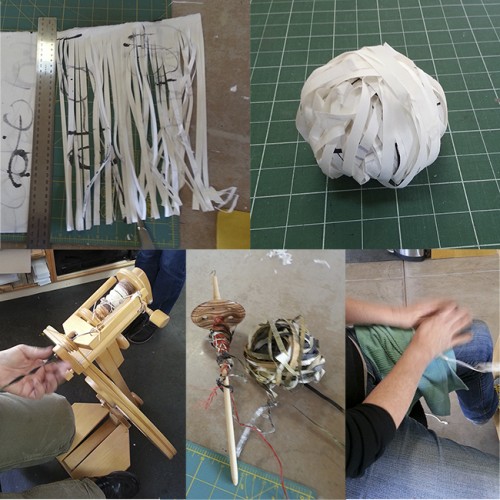
At Codex, Donna Seager had an intriguing piece by Lisa Kokin called Facsimile Two. Kokin says
I began to make faux pages and page spreads using the trimmed-down zippers that I had snagged at a fabric give-away months before. The first pieces were generic book pages, small, even, single-column blocks, made of just zippers and thread, with no reference to specific texts. After several months, the work entered the realm of specificity when I decided to work from particular books and to incorporate fabric as a substrate.
Below are 2 pieces, and detail on the first. You can see more about how she made them and why here.